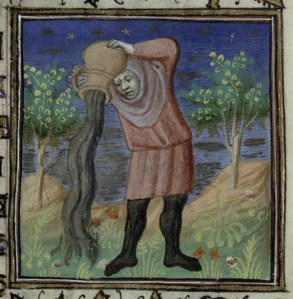
Happy New Year! This year we will be featuring the Labours of the Months from a few of our medieval Books of Hours at the beginning of each month.
Books of Hours were popular devotional texts in the middle ages. That is, they were produced for the laity rather than monastics or clergy and as such they were as richly decorated as the patron could afford. The Kalendar page for January pictured above is typical of Books of Hours, with painted miniatures showing the presiding zodiac sign and the Labour of the Month. The pages list important Saints’ Feast Days and other important dates in the Christian year, very often in red and blue and sometimes gold, as seen above.
To start the year off as we mean to continue, January’s labour of the month is feasting (in case you didn’t get enough of that in December). Feasting figures in Books of Hours are often shown sitting in front of a fireplace, showing that it was decidedly a time of year for indoor pursuits. There were several feast days in January, most significantly Epiphany or Twelfth Night, celebrating the revelation of Christ to the Magi and marked the end of the Twelve Days of Christmas. It was celebrated throughout the medieval Christian world, though the date varied depending on local tradition and which calendar was used (usually 5th January).

In medieval England, celebrations for Twelfth Night veered toward the anarchic and pagan, with the Lord of Misrule – appointed by chance to whoever found a bean in their slice of cake – presiding over the feast and giving orders as the rigid hierarchy was turned on its head. Other traditions from this time of year included Wassailing, based on the Anglo Saxon toast Wæs þu hæl, meaning “Be thou hale” or “Be in good health”. In the house-visiting Wassail tradition, peasants visited the home of their Landlord and sang carols in return for sweets or drink. Any Landlord found to be stingy with his “good cheer” was subject to curses and vandalism.
In cider-producing regions of England there was a variant of Wassailing known as Orchard-visiting Wassials. Participants went out to apple orchards and sang and drank to the health of the trees. They would make a racket to frighten away evil spirits and pour cider onto the roots of a tree as a sacrifice to ensure that the orchard would prosper in the coming year.

So this January leave those austere New Year’s Resolutions behind and instead feast in front of a fire, sing to your favourite apple tree and hope that there’s a bean in your slice of cake.

The images in this post come from Trin MS B.11.31, a 15th century French Book of Hours, and Trin MS B.11.22, a 13th century Flemish Book of Hours, both beautifully illuminated exemplars of their time periods.

Pingback: Labours of the Month: February | Trinity College Library, Cambridge